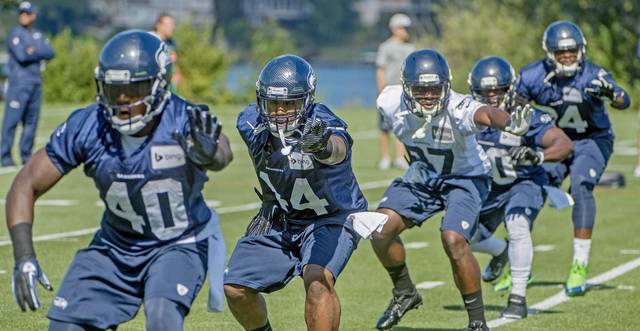03.16.17Lessons in Practice from the Seattle Seahawks
 My Practice Perfect co-author Katie Yezzi recently came across a pretty amazing video of Seattle Seahawks head coach Pete Carroll talking about practice and his approach to it. Beyond the key takeaway that practice is incredibly important to any performance profession–“Practice is everything,” Carroll says in the video–there are a ton of useful lessons for those of us who love to spend our time getting better at getting better.
My Practice Perfect co-author Katie Yezzi recently came across a pretty amazing video of Seattle Seahawks head coach Pete Carroll talking about practice and his approach to it. Beyond the key takeaway that practice is incredibly important to any performance profession–“Practice is everything,” Carroll says in the video–there are a ton of useful lessons for those of us who love to spend our time getting better at getting better.
Here are some of the key points the Teach Like a Champion/Practice Perfect team took from the video:
- “Practice is everything” Carroll says. Not only is the quality of practice a key competitive advantage–“We practice better than, sharper than anyone [else] can practice this game,” Carroll says. The way the team practices defines its culture and even its identity. The way the Seahawks play in games–famously up-tempo–is written all over their practices.
- Carroll goes on to say, “Practice is performance for us. We want to be really sharp and really precise.” What I think he means is that practice is a key way to communicate internally what our values and expectations are. It is our daily expression of them. It shows players what it means to be a Seahawk. Practice does not just reflect team culture; it creates it.
- “It starts with me. We have to set the tone intentionally as coaches…” This reminds us that it’s not just what you coach but how. The practices are intense but positive and fun. “You can see coaches juicing guys up…you can feel the energy.” A lot of people might not think it would be important for professional football players to have practice be fun but people do better work when they are happy, and a positive climate around practice builds a positive and supportive culture. And of course NFL teams compete for players. You’re more likely to want to play for a team where your work day is enjoyable and positive.
- On a related note, the team’s approach to feedback is intentional–a deliberate philosophy. As Carroll puts it: “We’re really disciplined as coaches to always talk about what we want to see, the desired outcome, not about what went wrong or what the mistake was. We have to be disciplined and always use our language to talk about the next thing you can do right. It’s always about what we want to happen, not about the other stuff.” Ok, can I observe that this is almost right out of TLaC, specifically the Live in the Now elements of technique 58, Positive Framing. (Wish I’d seen this video when I was writing; Carroll expresses the idea so perfectly I could have saved myself a lot of torturous editing.) The idea though is that the alchemy of feedback comes when you can give constructive feedback that feels positive and motivating. Teachers and coaches get told all the time to give three times as much praise as feedback. But that’s not quite it. Players and students who want to perform at an elite level need frequent constructive feedback. The key is to make that constructive feedback feel motivating. That’s what Pete’s talking about here.
- More evidence of how important feedback is: “One of the really simple guidelines that we use is that we critique effort first,” Carroll says. Two takeaways from this:The first is mundane but important. The team, the coaches, have guidelines for how they all give feedback–they have developed language to describe their shared approach to feedback to ensure that everyone uses it. The second is the content of the guideline Carroll described: “Critique effort first:” They chose their top cultural value—maximum effort—and have made sure they talk about it all the time. They align their feedback to their top value and always talk about it first before they go on to other things.
- The players start every practice by “tapping in”–an affirmative action that expresses their commitment and focus. When you walk onto the field, you leave everything else behind. That’s really important.Tapping in expresses that commitment affirmatively. It’s a routine invested with symbolic meaning. When that happens it becomes a ritual. Rituals are an important way to systematize culture.
- “We use a consistent format” Carroll says, which means everyone knows what to expect. A lot of coaches think they’ll change things up to make practice interesting and engaging. The Seahawks lose themselves in the content of the sessions because of their familiarity with the basic structure of how they work together. Practice always starts the same way. Energy is high. No one is trying to figure out where to be.
- Practice like you want to play: Carroll focuses on tempo. The Seahawks are renowned for their fast tempo style of play. You can see how they build it in practice. Carroll: “Up tempo. That’s how we want to play.” In practice they run to and through all the drills.” Practice reflects team culture, but it also creates it. Another key example of culture: Emphasis on competition “in everything”… there’s always a stake….we always keep score…. “the guy across from you makes you better.” This is a theme I’ve seen at the best youth soccer academies I’ve visited. Always camaraderie; always competition. A lot of people think those are opposites, contrary forces. In fact, they work in synergy.
By the way, if you like geeking out on practice and want to do more of it with like-minded people, please come join us in June for our Practice Perfect workshop. https://teachlikeachampion.org/practiceperfect/june2017
